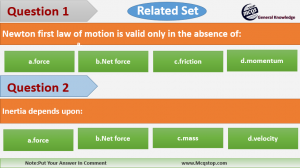Read important Physics MCQS For Exam.These physics General Knowledge Mcqs Contain of World Geography, Atmosphere, Science & Literature, events Mcqs, Current Affairs Mcqs , Pakistan Affairs Mcqs and International Organizations. These general knowledge questions are very important for all type of exams conducted by Fpsc, Nts, Kppsc, Ppsc, Spsc, Bpsc, Ots, Uts, Pts, Cts, Ats, etea and other testing agencies of Pakistan.
Note: The bold option is the right answer for the given MCQ’S:
1. In SI units a force is numerically equal to the , when the force is applied to it.
A. velocity of the standard kilogram
B. speed of the standard kilogram
C. velocity of any object
D. acceleration of the standard kilogram
E. acceleration of any object
2. Which of the following quantities is NOT a vector?
A. Mass
B. Displacement
C. Weight
D. Acceleration
E. Force
3. A newton is the force:
A. of gravity on a 1 kg body
B. of gravity on a 1 g body
C. that gives a 1 g body an acceleration of 1 cm/s
D. that gives a 1 kg body an acceleration of 1 m/s
E. that gives a 1 kg body an acceleration of 9.8 m/s
4. The unit of force called the newton is:
A. 9.8 kg · m/s
B. 1 kg · m/s
C. defined by means of Newton’s third law
D. 1 kg of mass
E. 1 kg of force
5. A force of 1 N is:
A. 1 kg/s
B. 1 kg · m/s
C. 1 kg · m/s
D. 1 kg · m2/s
E. 1 kg · m2/s

6. The standard 1-kg mass is attached to a compressed spring and the spring is released. If the
mass initially has an acceleration of 5.6 m/s, the force of the spring has a magnitude of:
A. 2.8 N
B. 5.6 N
C. 11.2 N
D. 0
E. an undetermined amount
7. Acceleration is always in the direction:
A. of the displacement
B. of the initial velocity
C. of the final velocity
D. of the net force
E. opposite to the frictional force
8. The term “mass” refers to the same physical concept as:
A. weight
B. inertia
C. force
D. acceleration
C. volume
9. The inertia of a body tends to cause the body to:
A. speed up
B. slow down
C. resist any change in its motion
D. fall toward Earth
E. decelerate due to friction
10. When a certain force is applied to the standard kilogram its acceleration is 5.0 m/s. When
the same force is applied to another object its acceleration is one-fifth as much. The mass of
the object is:
A. 0.2 kg
B. 0.5 kg
C. 1.0 kg
D. 5.0 kg
E. 10 kg
11. Mass differs from weight in that:
A. all objects have weight but some lack mass
B. weight is a force and mass is not
C. the mass of an object is always more than its weight
D. mass can be expressed only in the metric system
E. there is no difference
12. The mass of a body:
A. is slightly different at different places on Earth
B. is a vector
C. is independent of the free-fall acceleration
D. is the same for all bodies of the same volume
E. can be measured most accurately on a spring scale
13. The mass and weight of a body:
A. differ by a factor of 9.8
B. are identical
C. are the same physical quantities expressed in different units
D. are both a direct measure of the inertia of the body
E. have the same ratio as that of any other body placed at that location
14. An object placed on an equal-arm balance requires 12 kg to balance it. When placed on a
spring scale, the scale reads 12 kg. Everything (balance, scale, set of weights and object) is
now transported to the Moon where the free-fall acceleration is one-sixth that on Earth. The
new readings of the balance and spring scale (respectively) are:
A. 12 kg, 12 kg
B. 2 kg, 2 kg
C. 12 kg, 2 kg
D. 2 kg, 12 kg
E. 12 kg, 72 kg
15. Two objects, one having three times the mass of the other, are dropped from the same height
in a vacuum. At the end of their fall, their velocities are equal because:
A. anything falling in vacuum has constant velocity
B. all objects reach the same terminal velocity
C. the acceleration of the larger object is three times greater than that of the smaller object
D. the force of gravity is the same for both objects
E. none of the above
16. A feather and a lead ball are dropped from rest in vacuum on the Moon. The acceleration of
the feather is:
A. more than that of the lead ball
B. the same as that of the lead ball
C. less than that of the lead ball
D. 9.8 m/s.
17. Equal forces Fn act on isolated bodies A and B. The mass of B is three times that of A. The
magnitude of the acceleration of A is:
A. three times that of B
B. 1/3 that of B
C. the same as B
D. nine times that of B
E. 1/9 that of B
18. A car travels east at constant velocity. The net force on the car is:
A. east
B. west
C. up
D. down
E. zero
19. A constant force of 8.0 N is exerted for 4.0 s on a 16-kg object initially at rest. The change in
speed of this object will be:
A. 0.5 m/s
B. 2 m/s
C. 4 m/s
D. 8 m/s
E. 32 m/s
20. A 6-kg object is moving south. A net force of 12 N north on it results in the object having an
acceleration of:
A. 2 m/s, north
B. 2 m/s, south
C. 6 m/s, north
D. 18 m/s, north
E. 18 m/s, south
ans: A






Leave a Comment